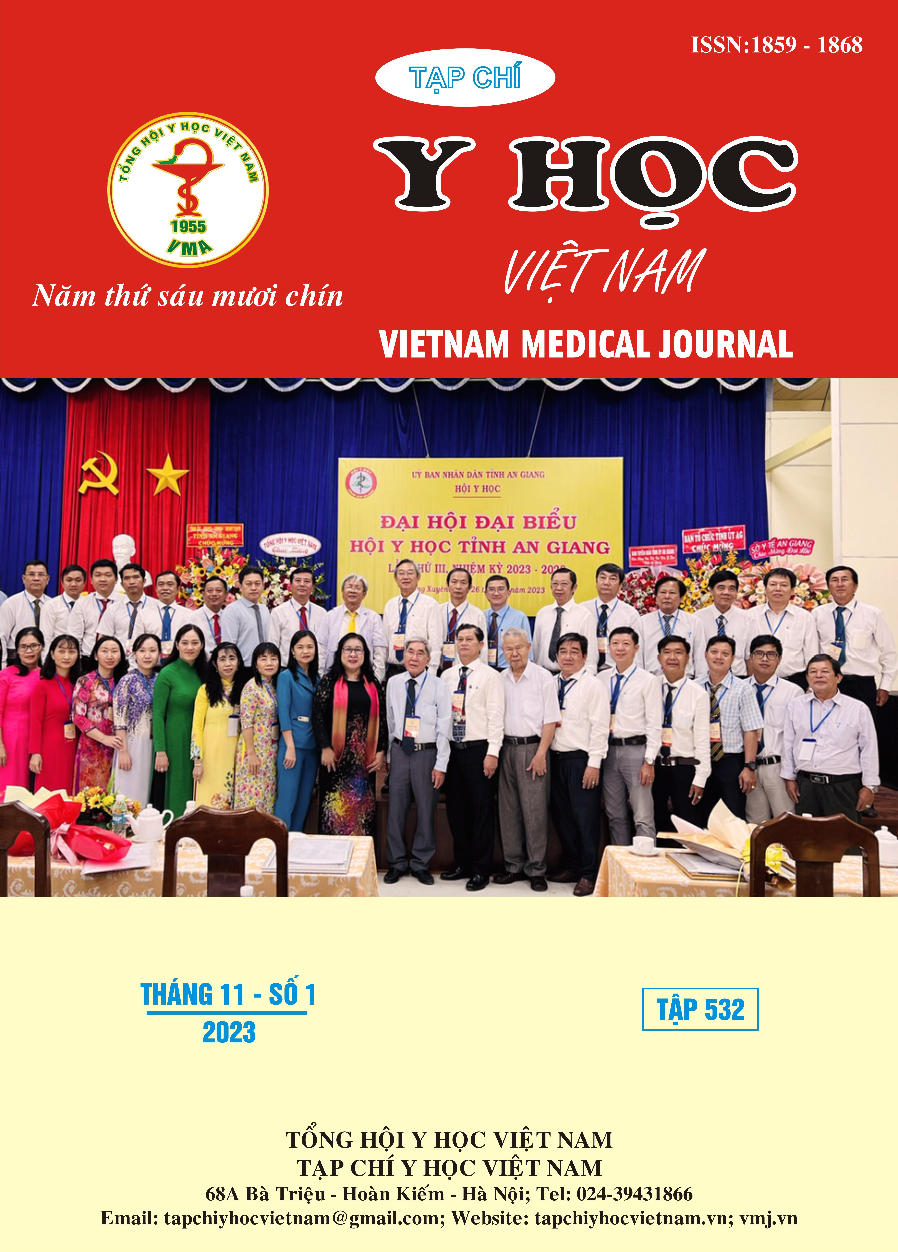MỐI LIÊN QUAN GIỮA TRIỆU CHỨNG LÂM SÀNG VÀ THĂM DÒ HÌNH ẢNH CỦA THOÁI HÓA KHỚP BÀN NGÓN CHÂN I NGUYÊN PHÁT
Nội dung chính của bài viết
Tóm tắt
Mục tiêu: Mô tả triệu chứng lâm sàng, x-quang và siêu âm ở bệnh nhân thoái hóa khớp bàn ngón chân I nguyên phát và khảo sát mối liên quan giữa triệu chứng lâm sàng với xquang và siêu âm ở nhóm đối tượng nghiên cứu. Đối tượng và phương pháp nghiên cứu: Nghiên cứu mô tả loạt ca bệnh trên 50 bệnh nhân có triệu chứng sưng và/hoặc đau và/hoặc hạn chế vận động và/hoặc biến dạng vùng khớp bàn ngón I bàn chân đến khám ngoại trú tại phòng khám Cơ xương khớp Bệnh viện Bạch Mai từ tháng 08 năm 2022 đến tháng 08 năm 2023. Kết quả: Tuổi trung bình của nhóm bệnh nhân nghiên cứu là 59,2 ± 9,4. Phân độ thoái hóa khớp bàn ngón chân I trên X-quang chủ yếu ở độ 1 và 2 với tỷ lệ lần lượt là 61% và 32%. Hình ảnh tổn thương trên siêu âm thường gặp nhất là gai xương 67,2%, dịch khớp và dày màng hoạt dịch ít gặp hơn với tỷ lệ 23% và 8,2%. Mức độ thoái hóa khớp trên X-quang càng nặng thì mức độ đau càng tăng, khác biệt có ý nghĩ thống kê với độ tin cậy 95%. Có mối liên quan giữa sự xuất hiện của hình ảnh gai xương trên siêu âm và mức độ biến dạng khớp, hạn chế vận động trên lâm sàng. Kết luận: Có mối liên quan chặt chẽ giữa mức độ nặng của các triệu chứng lâm sàng với phân độ tổn thương trên X-quang và hình ảnh gai xương trên siêu âm.
Chi tiết bài viết
Từ khóa
khớp bàn ngón chân I, thoái hóa khớp.
Tài liệu tham khảo
2. Bergin SM, Munteanu SE, Zammit GV, Nikolopoulos N, Menz HB. Impact of first metatarsophalangeal joint osteoarthritis on health-related quality of life. Arthritis Care Res. 2012;64(11):1691-1698. doi:10.1002/acr.21729
3. Murphy L, Helmick CG. The impact of osteoarthritis in the United States: a population-health perspective: A population-based review of the fourth most common cause of hospitalization in U.S. adults. Orthop Nurs. 2012;31(2):85-91. doi:10.1097/NOR.0b013e31824fcd42
4. Menz HB, Harrison C, Britt H, Whittaker GA, Landorf KB, Munteanu SE. Management of Hallux Valgus in General Practice in Australia. Arthritis Care Res. 2020;72(11):1536-1542. doi:10.1002/acr.24075
5. Menz HB, Roddy E, Marshall M, et al. Demographic and clinical factors associated with radiographic severity of first metatarsophalangeal joint osteoarthritis: cross-sectional findings from the Clinical Assessment Study of the Foot. Osteoarthritis Cartilage. 2015;23(1):77-82. doi:10.1016/j.joca.2014.10.007
6. Senga Y, Nishimura A, Ito N, Kitaura Y, Sudo A. Prevalence of and risk factors for hallux rigidus: a cross-sectional study in Japan. BMC Musculoskelet Disord. 2021;22(1):786. doi:10.1186/s12891-021-04666-y
7. Natural History of Radiographic First Metatarsophalangeal Joint Osteoarthritis: A Nineteen-Year Population-Based Cohort Study - PubMed. Accessed July 23, 2023. https://pubmed.ncbi.nlm.nih.gov/31233277/
8. Keen HI, Redmond A, Wakefield RJ, et al. An ultrasonographic study of metatarsophalangeal joint pain: synovitis, structural pathology and their relationship to symptoms and function. Ann Rheum Dis. 2011;70(12):2140-2143. doi:10.1136/annrheumdis-2011-200349


